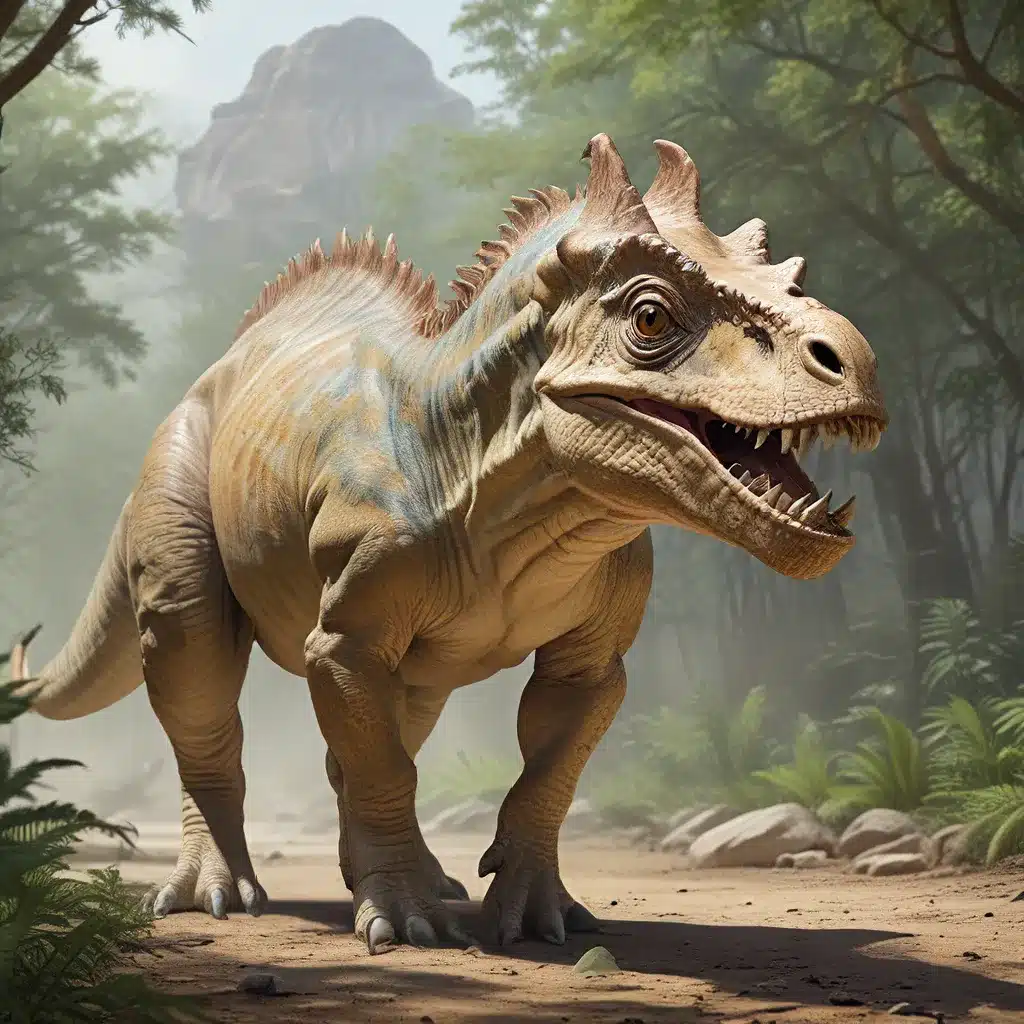
Amidst the diverse array of dinosaurs that once roamed the Earth, the Pachycephalosaurus stands out as a particularly fascinating and enigmatic creature. This dome-headed herbivore, known for its distinctive skull structure, has captivated the imaginations of paleontologists and enthusiasts alike, as they unravel the secrets of its evolutionary history and adaptations.
The Distinctive Skull of the Pachycephalosaurus
The Pachycephalosaurus, a member of the Pachycephalosauridae family, is characterized by its remarkably thick and domed skull. This unique feature has long been a source of fascination and speculation among researchers. The skull, which could reach up to 10 inches (25 cm) in thickness, is believed to have served a variety of purposes, from head-butting behavior to display and social interaction.
One of the leading theories regarding the function of the Pachycephalosaurus’ skull is that it was used in head-butting competitions, similar to the behavior observed in modern-day bighorn sheep. This hypothesis is supported by the presence of thick, bony protrusions on the top of the skull, which would have provided a sturdy platform for such confrontations. Studies of the skull’s structure and biomechanics have suggested that it was well-equipped to withstand the forces generated during these head-to-head encounters.
However, the skull’s function is not limited to just head-butting. Researchers have also proposed that the Pachycephalosaurus used its domed head for display and social signaling. The striking appearance of the skull, with its distinct ridges and bumps, may have played a role in establishing dominance, attracting mates, or communicating with other members of its species. This theory is further supported by the observed sexual dimorphism within the Pachycephalosauridae family, where males often exhibited more pronounced cranial features than females.
Evolutionary Origins and Adaptations
The evolutionary history of the Pachycephalosaurus is a topic of ongoing research and debate. Paleontologists have uncovered a diverse array of Pachycephalosaurid fossils, ranging from smaller, earlier species to the larger, more prominent Pachycephalosaurus itself. This suggests a complex and dynamic evolutionary lineage, with various adaptations and specializations emerging over time.
One particularly fascinating aspect of the Pachycephalosaurus’ evolution is its relationship to other dinosaur groups. While it was once classified as a close relative of the Ceratopsidae (horned dinosaurs), more recent evidence suggests that the Pachycephalosauridae may have actually shared a closer evolutionary relationship with the ornithopod dinosaurs, such as Iguanodon and Hadrosaurs. This reclassification has led to a reevaluation of the Pachycephalosaurus’ adaptations and its place within the broader dinosaur family tree.
In addition to its distinctive skull, the Pachycephalosaurus also exhibited other unique adaptations that contributed to its survival and success. For instance, studies have shown that it possessed a relatively small body size compared to other herbivorous dinosaurs, which may have allowed it to navigate and forage in densely vegetated environments more effectively. Additionally, its herbivorous diet, relying on a diverse range of plant matter, likely provided it with a sustainable source of nutrition in its ecosystem.
Significant Pachycephalosaurus Discoveries
The story of the Pachycephalosaurus is not only about its unique anatomy and evolutionary adaptations but also the fascinating discoveries that have contributed to our understanding of this remarkable dinosaur.
One of the most significant Pachycephalosaurus discoveries occurred in the late 1980s, when a well-preserved skull was unearthed in Montana, USA. This fossil, known as the “Dome of Doom,” provided researchers with an unprecedented opportunity to study the intricate details of the Pachycephalosaurus’ skull structure and its potential functions. The discovery of this specimen, along with other Pachycephalosaurid fossils, has greatly advanced our knowledge of the group’s biology and behavior.
In addition to the “Dome of Doom,” other notable Pachycephalosaurus discoveries have helped to shed light on the dinosaur’s geographic distribution and the environments it inhabited. Fossils have been found across North America, from the badlands of Montana to the deserts of Utah, indicating that the Pachycephalosaurus was widely distributed and able to adapt to a variety of ecological niches.
Emerging Theories and Future Research
As with many aspects of dinosaur paleontology, the study of the Pachycephalosaurus continues to evolve, with new theories and discoveries constantly challenging our understanding of this unique creature.
One area of particular interest is the potential role of the Pachycephalosaurus’ skull in intraspecific communication and social behavior. While the head-butting hypothesis remains widely accepted, some researchers have proposed alternative explanations, such as the use of the skull for visual displays or even as a means of producing and transmitting auditory signals. As new evidence and analytical techniques become available, our understanding of the Pachycephalosaurus’ social dynamics and communication methods may continue to be refined.
Another intriguing area of research involves the Pachycephalosaurus’ relationship to other dinosaur groups. The recent reclassification of the Pachycephalosauridae has opened up new avenues of investigation, with paleontologists exploring the evolutionary connections between these dome-headed herbivores and their ornithopod counterparts. Understanding these relationships could provide valuable insights into the broader patterns of dinosaur evolution and the complex interplay between various lineages.
As we delve deeper into the fascinating world of the Pachycephalosaurus, The Lost Kingdoms remains committed to uncovering and sharing the latest discoveries and theories surrounding this captivating dinosaur. Through continued research, exploration, and collaboration, we may one day unravel the full evolutionary secrets of the Pachycephalosaurus, further expanding our understanding of the dynamic and ever-evolving world of prehistoric life.


